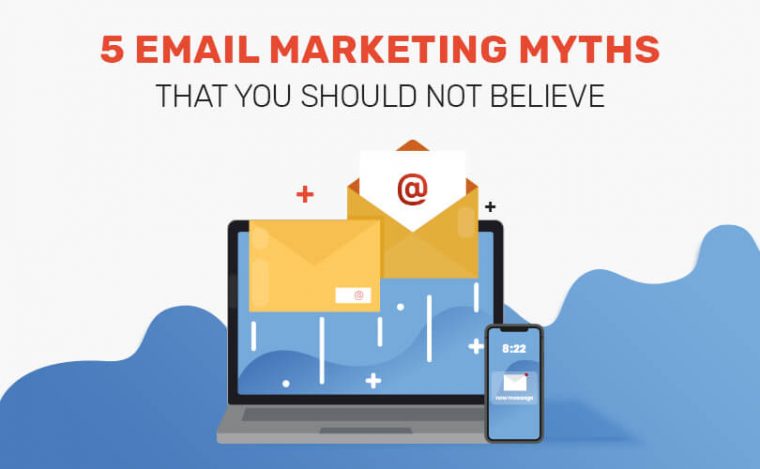


Depending on how you interpret them, myths can keep you from the truth. And maybe it’s because the competition is so fierce, or the fact that you can’t afford to lose a marketing campaign, but you start to believe in these myths.
Just as there are other areas in the marketing world, there are myths within email marketing. For instance, how many times have you heard that?
It’s because of these myths that some marketers have decided to avoid email marketing but what they don’t realize is that to be an exceptional marketer, you need to stop believing in these myths and figure out what works and what doesn’t by yourself.
So, in this blog, we’ll be going over five email marketing myths to avoid and help you to guide your email strategy.
This is one of the biggest myths in regard to email marketing. Do you think it’s wise to quit emailing your partners, clients, or potential customers simply because someone writes in a magazine that email marketing is dead? No.
According to a study by Radicati Group in 2018, there are over 6.69 billion email accounts. Moreover, Statista’s email marketing statistics show that active email accounts are expected to hit 5.6 billion this year.
One of the main reasons behind the popularity of email marketing is that your competition is already taking advantage of it; other companies, retailers, and organizations are using this strategy to market themselves.
However, it’s essential to use relevant messages with this strategy as subscribers have become familiar with spam email, resulting in ignoring emails or trashing them. In the end, it’s crucial to send tested and optimized emails that no matter what your intentions may be, the content is fresh, unique, and engaging.
Image Source: Statista
You may also be surprised to know that users who visit websites through an email are more inclined to make a purchase than those who find your website through social media and ads. This clearly showcases the power of email marketing and its ROI conversions.
When creating your emails, it’s important to focus more on how to capture a user’s attention with your content rather than focusing solely on making a sale.
And during this process, you need to be sure and not send too many emails. Sending emails every day doesn’t work. If you aren’t grabbing the attention of your target market, it won’t matter how often you’re sending emails.
Don’t focus on short-term conversions; instead, keep your attention on engaging users. You want to ensure that once you’ve gotten their attention, they’ll be a committed customer.
Think of it this way – if you craft each email simply for conversions, you’re going to end up promoting your product or service all the time. Moreover, if you’re sending these emails on an irregular basis without a plan, you could end up having high unsubscribed rates, complaints, and negative feedback.
In the end, subscribers will stop opening your emails, ultimately effecting the domain and IP reputation.
You may have heard people mention that the best time to send your emails is on a Monday or Friday before 10 am or after 6 pm. So while this may work for some, the truth is there is no perfect day or time to send your emails out.
So, the big question is, how do you choose the perfect timeframe for sending your emails? There is no right answer to this question. While one time of day may work for one person, it may not work well for the next.
You also need to know who your audience is before sending emails out. You can do this by analyzing your previous campaigns and running A/B tests with variations in subject lines, preview text, email template, and multiple images.
After analyzing audience behavior based on a variety of factors such as demographics, country, state, city, age, gender, and device, you may find the best day and time for your subscribers.
Speaking of finding the best time to send an email, Fridays and Saturdays are two days in which people have enough time to check their emails, from a general perspective. However, this does not apply to everyone. For example, while one person may check their emails after a long workday, another might decide to have a relaxing night and go to bed early.
So, for you to get the best open/click rate, you’ll need to send your emails to various subscribers at various times.
Image Source: Coschedule
Email segmentation is one of the practical approaches that email marketers have taken to reach their target audience.
This process is where you divide your email list into smaller groups, such as segments or tags. By understanding the specific characteristics that differentiate these groups, you can tailor your content to improve your conversions.
According to Mail Chimp, click-through rates are 100.95% higher in segmented email campaigns than non-segmented campaigns.
Image Source: MailChimp
The earlier you separate these segments and groups, the higher your chances are of emailing your target audience and getting the best results.
Moreover, email marketing automation can also help to deliver your messages and segment your campaigns. As per the ultimate marketing automation statistics study by Email Monday, on average, 51% of companies are currently using marketing automation.
When sending emails, we advise you to add only limited number of images in an email. We also recommend adding an ALT text & short caption for the image and make sure the image is optimized correctly.
As a result, the smaller size image will load fast, create quick engagements, and drives more conversions. Another interesting fact is that when users see a catchy subject line, they are more likely to open the email; however, if the image doesn’t appear or it takes too long to load, they’ll close out quickly. As a result, there will be an open rate, but no click rate, meaning your overall conversion rate will be lower.
For instance, Microsoft Outlook blocks all images by default. So, it’s best to figure out the number of users with a particular email service and send your messages accordingly. If you have a shorter list of recipients, you can make this decision based on the majority of the audience through email analytics.
On the other hand, email users can always change their preferences to enable missing images to display in various email clients.
There are organizations all over the world who are experiencing a rise in business due to the use of email marketing. They are consistent with sending strategized promotional emails, blogs, sale alerts, company announcements, press releases, and automated campaigns to their subscribers. Also, they ensure that once their users receive these emails, they are guided to the most relevant landing page.
Overall, it will help your business tremendously if you stop believing in these myths. Research how you can decrease email marketing mistakes and take the necessary measures in correcting them; before you know it, you’ll start to generate a significant amount of ROI from your email marketing.
Don’t think about a lead as some possible client, think about them as an opportunity. Present your subscribers with a well-crafted email that will drive conversions, bring results, and grow your readership.
If you have questions about lead generation through email marketing, building your subscribers list, or how to approach this strategy, Cibirix can help you! Contact us now, and we will help your business grow digitally.

Since founding Cibirix, Ashish has leveraged his marketing degree to lead the agency in crafting meaningful digital marketing experiences for clients. His results-driven approach is a unique mix of analytical thinking, crisp visual aesthetics and a desire to simplify frontends while developing robust architecture. With a passion for design, technology, & marketing, He leads each aspect of the agency’s business and oversees its talented team of digital professionals.